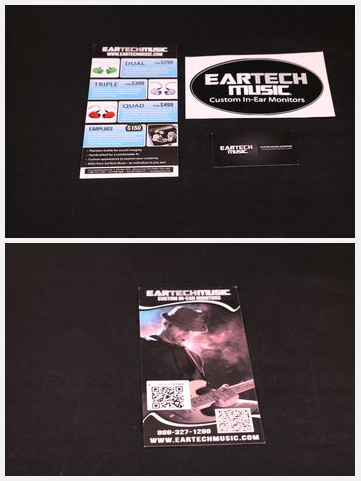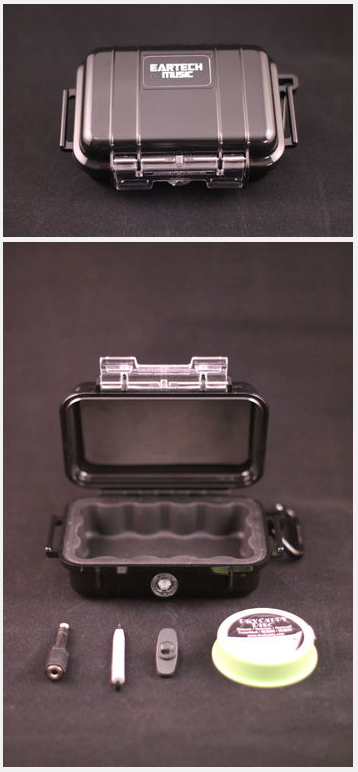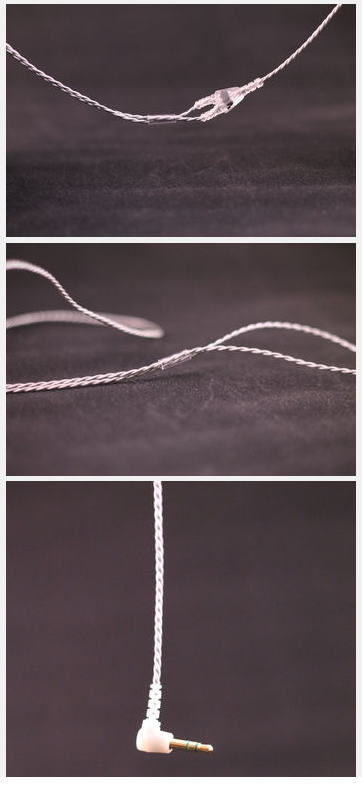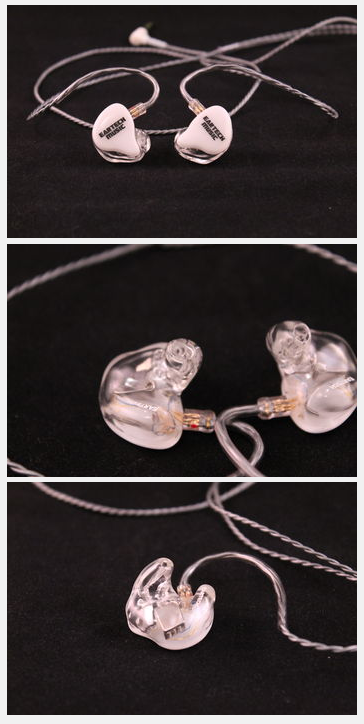Review and photos by acain, posted on www.head-fi.org
Pros: Affordable, Balanced sound, A+ Customer Service
Cons: They don’t advertise other then that for the price I can’t find any.
EarTech Music—Have you ever heard of them or Ear Technology Corporation? Well, me neither. This review is for EarTech Music Dual driver custom in-ear monitor. I ran upon this company one day while I was actually doing a search for “Ear Werks,” and I must have typed something wrong with my fat little fingers. Somehow or fate, EarTech Music came up. So, being into music and audio, I clicked the link, and come to find out they made custom in-ear monitors. Like everyone else on Head-Fi, I researched their products and came up with only one review that was written in Bass Musician Magazine. That only left me more curious about them. Naturally, writing reviews as a hobby, I contacted the company to find out more about them. I was in the market for a CIEM (custom IEMs) that had a neutral response with a little bass extension for everyday listening. Richard (one of their techs) emailed me back and suggested their duals or triples would suit my needs. So, through tons of emails, I had Richard help me to get into a pair of dual customs. I must have sent him a dozen emails just to find out how their company came about. Let’s get started, and find out who Ear Technology is. Before I get started, I am not an employee or am I being compensated for writing this review for EarTech Music.
So where did this company come from? It all started from its parent company, Ear Technology Corporation that Daniel R. Schumaier, PhD started that makes hearing aid products. Dr. Schumaier has numerous patents and has an extensive background in audiology. Who better to make customs than a hearing aid company? EarTech Music started to make custom IEMs late of 2011. It all started when their shell guy asked Richard if he could wire up some monitors for his son. Their primary shell guy is Drew, who has 25+ years of ear shell experience (handcrafting acrylic shells for custom IEMs). Richard has 25+ years of electronics and has previously work for Texas Instruments and Siemens. Then there’s Stan, one of their other lab guys that has several years of audio testing experience. On top of all their experience, they have the backing of their parent company, Ear Technology Corporation. They started to sell their custom IEMs in 2012, mostly in their local area to professional musicians and audio engineers. To this day, they have very little marketing, and go by word of mouth through the professional community.
I finally got my duals within about 2 1/2 weeks from them receiving my impressions, so let’s see if they’re Head-Fi worthy. My duals are clear with white faceplates and black laser etched logo that cost $299.
Specifications
- Frequency Response: 18Hz – 18 Khz
- Impedance: 27 ohms
- Sensitivity: 120 dB SPL/mW @ 1kHz
- Noise Isolation: -26 db
Accessories
- Black Pelican Case
- 1 Ear wax cleaning tool
- 1/4 inch Adaptor
- Shirt Clip
- 1 DryCaddy Disc
- 2pin 50 inch cable (silver coated copper wire)
EarTech Music includes every accessory that you would expect. They also give you the option of two different cable lengths and cable colors. I really like the case they provide. I know some companies will give you a tin can to put your monitors in. On their website, they have an online Custom IEM designer that will show you what your monitors will look like. They offer just about every color under the rainbow. They also offer exotic woods for the faceplate, or you can go with a transparent or solid color. Under accessories, you can also buy a cable with an inline mic for cell phone use. I have been looking for one for the longest time that is reasonably priced, and didn’t know they carried them until I got my customs.
Build And Fit
Buying a custom, there is always the chance of needing a refit. I have owned customs from three other companies (not going to mention names). There hasn’t been one time where I didn’t need a refit, and on one occasion, I needed 4 refits. So getting a pair of customs from a company that I knew little about and no other reviews, I was skeptical on how the quality would be. Before I get into the shell quality, I will start with the cable. The cable I picked was gray with 2 pin connectors. It’s your standard custom cable, but it’s silver coated oxygen free copper. It’s a twisted cable with a 90 degree plug, with good strain relief. The Y splitter is clear, which goes nice with the gray cable with good strain relief. The cable is coated in a smooth rubber, so you won’t have to worry about cable noise from rubbing on your clothing. The plug is white, with a very low profile, and is also gold plated.
The shell to my surprise was flawless. I chose clear so I can see all the drivers, with white faceplates. Clear as crystal. I couldn’t believe how clear the body was. Some clears can have a yellowish tint, but these were like glass. To top it off, it was smooth as glass. Very impressive for being hand poured into a negative mold. Just about every previous custom that I have owned, I would be able to find some air bubbles that were very visible. I had to look really hard to find any kind of imperfection, only to find none. You can really tell that their lab guys have been doing this for a while, and I give them all the credit in the world for attention to detail. The faceplate is also flawless. You cannot tell that it was glued on to the body. It is seamless with no visible lines. I had their logo put on each faceplate in black, and they laser etch their artwork. They also offer custom artwork that you can send to them. What really stands out to me is that both of the earpieces are symmetrically the same. I have seen many customs where the shapes were very different. You can tell when a company just wants to get a product out the door, and move on to the next one. You can read through forums on Head-Fi where very popular companies have done some real bang up jobs on their artwork and their shell quality. EarTech’s lab guys really put the extra effort in to make sure their products are 110 percent. If I didn’t know how custom IEMs were made, I would have thought the shells were injection molded—that’s how good they look.
How did they fit me? Well, this is the first time I don’t have to send a custom back for a refit, to my relief. Getting customs is a big process, and very personal. It’s a long waiting period with a lot of anticipation. The last thing you want to do after waiting is to send them back for a refit. Their lab guys prefer open mouth impressions. Some companies prefer closed mouth. It all depends on their process. Every tech has their own artistic approach. It is very well a skilled art, making custom IEMs. I have been into DIY customs for about a year, and it is a very detailed job. I have been told from other custom companies that I would have to pick a different model, because of how small my ears are. I was amazed on how the placement of the drivers match each shell the same. The bore of the nozzle is two tubes going into one large bore. They use Knowles and Sonion balanced armatures in their monitors. In my duals, there is the popular Knowles CI and Sonion center drive armature for better frequency response. They tune their drivers with passive crossover networks and dampers. After 15 minutes of wearing them, they disappeared and I couldn’t even tell they were there. I had no issues with the seal breaking, which is very important for maximum listening. So overall, I couldn’t be happier with the fit and build. I would like to say thanks to their lab guys for doing a great job, and having to deal with my small ears.
Sound
The whole reason why audiophiles got into the custom in-ear monitor market was looking for the best sound possible. Custom IEMs are made for live musicians and engineers. That’s why audiophiles turned to customs—looking for the best way to reproduce music how it was supposed to be heard. I don’t consider myself an audiophile, but a headphone and music enthusiast, mainly into portable audio and IEMs. Before I came across EarTech Music, I was in the market for a reference in-ear monitor with a flat neutral signature, but I also wanted something with some bass extension for everyday listening. So how did the duals sound? They sounded great and neutral like I wanted. My main source was my Astell & Kern AK100II DAP. I also used a Fiio X1, HiSound Audio Nova N1, and Audioengine D1 DAC fed from a Lenovo Ultrabook. All my files were 16bit ripped WAV file or 24bit FLAC files. The duals were very easy to drive. I didn’t bother stacking an amp with them.
Listening to the Foo Fighters “Wasting Light”, the duals performed exceptionally well. Neutral-sounding customs, I find really shine with live recordings. No frequencies were over-extended, and sounded very well balanced. The sound was flat in a good way, and with a slight emphasis on mid-bass, just like I wanted for everyday listening. I would have liked a little more low-end thump, but they are tuned to how they said they were, and I wanted a neutral sounding custom. Soundstage is above average for a dual set up. It’s right on par for an in-ear monitor. Imaging and separation is one of the duals’ strong points, where you can clearly picture where instrument placement is. Listening to mp3’s, Eartech’s duals can be very revealing to bad recordings. But, that’s a good thing, so it’s not adding coloration to any of your music, and is playing it back how it’s formatted with bad recordings. Picking up small details in live recordings, for instance, in one song you could hear the singer taking a drink of some kind of beverage. I always use Led Zeppelin’s “Stairway to Heaven” to see how the dynamics are. The duals performed better then average. The only IEM that I have that I could really compare them to would be UE 900S. The duals have less emphasis on bass compared to the 900S, and the duals’ midrange with female vocals sounds more realistic. The 900S’ upper frequency extends better then the duals. I guess the 900S are more V shaped to my ears. EarTech’s duals are neutral sounding and reproduce music with no coloration. If you want a custom that has hard-hitting bass, these are not for you (eartech note: duals are not designed for extended bass. Triple and Quad driver models will provide thunderous bass if you are looking for that). If you want to listen to your music how it was mastered, these are for you. It is very hard to describe a flat sound signature, because nothing is added or taken away from the music.
Conclusion
Buying custom in-ear monitors is very personal and can be expensive. Customer service can make or break a sale. EarTech Music’s Richard was the best person I have ever dealt with, and I can say as a whole company they put the customer first. They had no problem answering any question I had about the company, and any of my emails were answered the same day or the next. EarTech Music has a dual, triple, and quad in their line up at very reasonable prices. Their shell quality is some of the best that I have ever seen and were delivered in within 2 1/2 weeks. If you’re in the market for a reference style custom, I would recommend these to anyone. Or if you’re looking to get into customs, these are very reasonably priced with quality that should be a standard for other companies. I came across them by chance. They don’t market their product, and cater to audio engineers and professional musicians. That must say something about the quality of their products. Thanks for reading. I hope you check them out. They take great pride in their products, and are in no rush to just put a product out until it meets their high standards.





